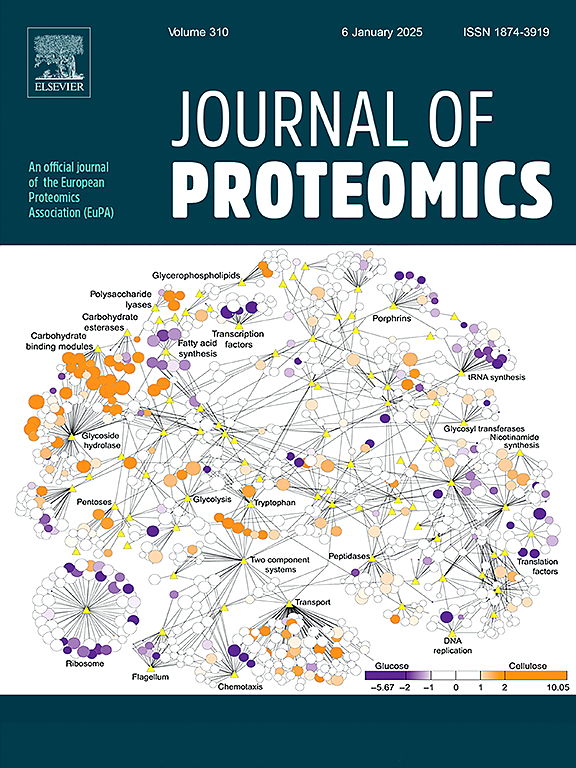Proteomic interrogation of complex biomedical samples using the rapid denaturing organic digestion (DOD) method
IF 2.8
2区 生物学
Q2 BIOCHEMICAL RESEARCH METHODS
引用次数: 0
Abstract
Limitations to many current aqueous-based tryptic digestion methods include lengthy digestion times and both relatively high inter- and intra-day variability for both characteristic peptides identified and sequence coverages. This report describes results from digestion of some complex biomedical samples using the rapid Denaturing Organic Digestion method (DOD), an organic solvent-modified digestion method previously optimized for targeted protein digestion. Advantages of the DOD method included a very rapid digestion only requiring inexpensive solvents and reagents generally available in the laboratory, with no requirement for specialized equipment or expensive, specialized consumables. For this study, samples of E. coli and murine ileum protein extracts, and K562, a mass spectrometry-compatible human protein extract and reference standard routinely used to evaluate methods, were digested. Sequence coverage and characteristic peptide identification results were compared to those from 18 and 24 h conventional aqueous-based digestion methods. Across the samples tested, though the number of characteristic peptides and sequence coverages produced by the 5 min DOD method were very similar to those produced by the aqueous-based digestion methods, the specific characteristic proteins and their corresponding tryptic peptides identified following DOD method digestion included more hydrophilic and less hydrophobic species. In addition, we explored the effect of increasing digestion times with complex samples from 5 to 30 and 90 min for the DOD method. Increasing the digestion time to ≥30 min resulted in improved intra-day precision and the identification of many more peptide products than the currently used aqueous methods to which it was compared. These results suggest that the DOD organic-modified digestion method could, while markedly reducing protein digestion time, also provide more precise analysis and access to a somewhat different area of the proteome than that provided by current aqueous-based digestion methods.
Significance
The DOD tryptic digest method is a very simple and rapid process with no requirement for expensive equipment or consumables. The method markedly reduces tryptic digestion time and cost, and substantially improves within-batch and across-analyst precision for peptide and sequence coverage results over methods to which it was compared. Importantly, it also provides access to a somewhat different subset of the proteome with different peptide products identified as compared to aqueous solvent-based digestion providing potential for increased proteome coverage for bottom-up analysis if used in conjunction with aqueous-based methods.

使用快速变性有机消化(DOD)方法对复杂生物医学样品进行蛋白质组学分析。
目前许多基于水的胰蛋白酶消化方法的局限性包括消化时间长,所鉴定的特征肽和序列覆盖范围的日间和日间变异性相对较高。本报告描述了使用快速变性有机消化方法(DOD)消化一些复杂生物医学样品的结果,DOD是一种有机溶剂修饰的消化方法,先前针对靶向蛋白质消化进行了优化。DOD方法的优点包括非常快速的消化,只需要实验室中通常可用的廉价溶剂和试剂,不需要专用设备或昂贵的专用耗材。在本研究中,消化大肠杆菌和小鼠回肠蛋白提取物的样品,以及K562(一种质谱兼容的人类蛋白质提取物和常规用于评价方法的参考标准)的样品。序列覆盖度和特征肽鉴定结果与18和24 h常规水基消化法比较。在测试的样品中,虽然5 min DOD方法产生的特征肽的数量和序列覆盖率与水基消化方法产生的非常相似,但DOD方法消化后鉴定的特定特征蛋白及其相应的色氨酸包括更多的亲水性和更少的疏水性物种。此外,我们还探索了增加复杂样品的消化时间(从5到30和90 min)对DOD方法的影响。将消化时间增加到≥30 min,与目前使用的水相方法相比,可以提高当天的精度和鉴定更多的肽产物。这些结果表明,DOD有机修饰的消化方法在显著缩短蛋白质消化时间的同时,也提供了比目前基于水的消化方法更精确的分析和进入蛋白质组的不同区域。意义:DOD色氨酸消化法是一种非常简单快速的方法,不需要昂贵的设备和耗材。该方法显著减少了胰蛋白酶消化时间和成本,并大大提高了肽和序列覆盖结果的批内和跨分析师精度。重要的是,与基于水的方法结合使用,它还提供了与基于水的方法相比,确定的不同肽产物的蛋白质组的不同子集,为自下而上的分析提供了增加蛋白质组覆盖率的潜力。
本文章由计算机程序翻译,如有差异,请以英文原文为准。
求助全文
约1分钟内获得全文
求助全文
来源期刊

Journal of proteomics
生物-生化研究方法
CiteScore
7.10
自引率
3.00%
发文量
227
审稿时长
73 days
期刊介绍:
Journal of Proteomics is aimed at protein scientists and analytical chemists in the field of proteomics, biomarker discovery, protein analytics, plant proteomics, microbial and animal proteomics, human studies, tissue imaging by mass spectrometry, non-conventional and non-model organism proteomics, and protein bioinformatics. The journal welcomes papers in new and upcoming areas such as metabolomics, genomics, systems biology, toxicogenomics, pharmacoproteomics.
Journal of Proteomics unifies both fundamental scientists and clinicians, and includes translational research. Suggestions for reviews, webinars and thematic issues are welcome.
 求助内容:
求助内容: 应助结果提醒方式:
应助结果提醒方式:


